Which Cuts of Meat are Best for Jerky?
You want to use cuts of beef that are lean.
Good candidates include:
- Eye of Round
- Bottom Round
- Top Round
- Brisket Flat
- Flank steak
- Sirloin
For this article, I used “petite sirloin steaks” – while these aren’t particularly cheap, they are lean; I also had them frozen in my freezer for 3 months so that’s what I opted to use.
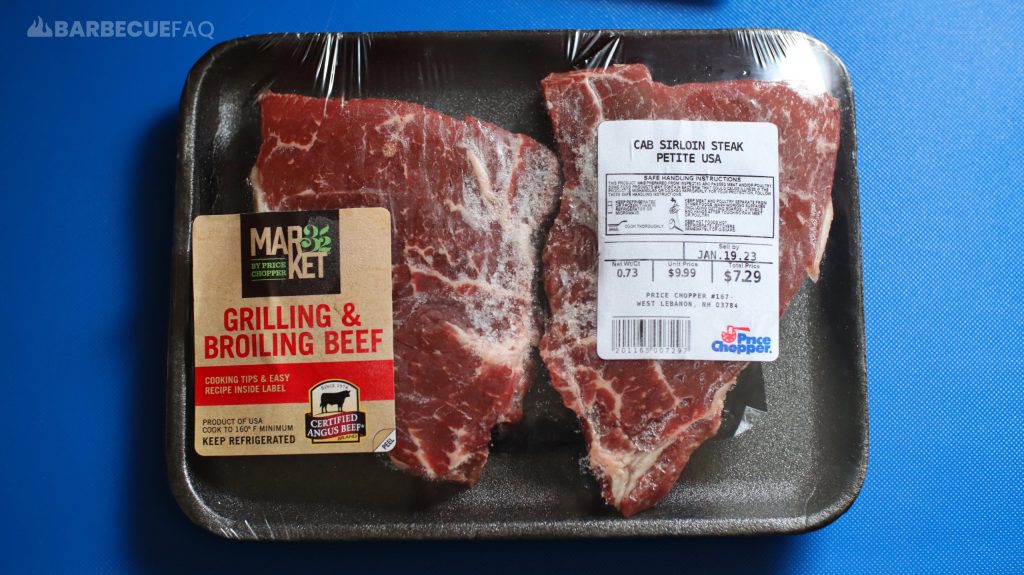
The reason for the lack of fat is because fat won’t preserve well nor will it render. Rather it will go rancid quicker.
If my intention is preservation, I’ll even go as far as to trim un-rendered fat with kitchen shears.
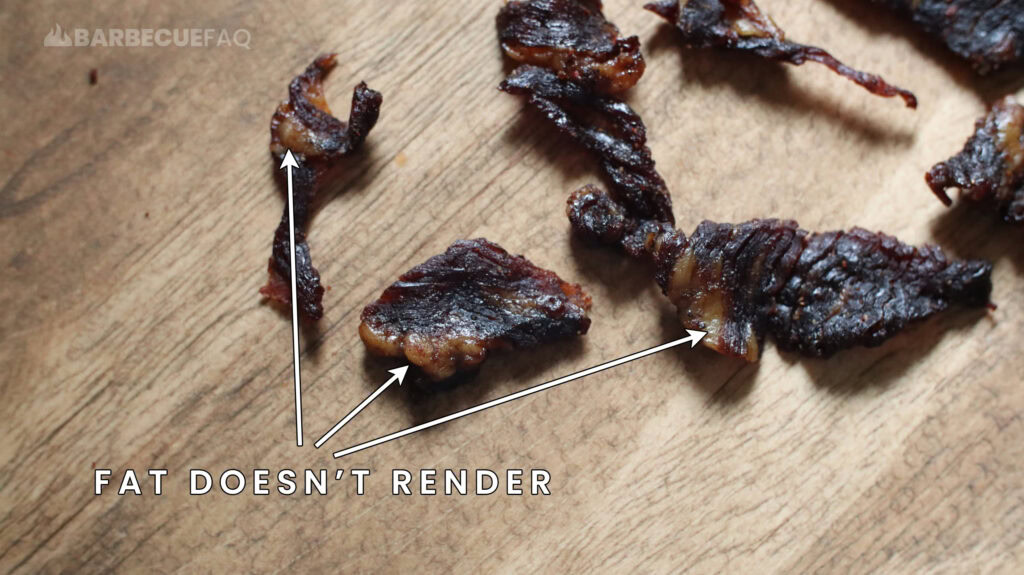
Slicing Meat for Beef Jerky
Before slicing your meat into strips, you need to determine your taste preference.
Meaning, do you prefer soft or jerky with a “tug.”
- For tender/soft jerky you’d slice against the grain structure of the beef.
- If you prefer a bit of “tug” in your bite you’d slice with the grain.
The grain directions would look like this:

Aside from that, it’s also recommended to slice around 1/8 – 1/4 inch thick.
Making a Marinade
The recipe in this article is based on around 0.5 – 1 lb of meat.
I’d suggest sticking to the quantities I list and work in batches of 1 lb rather than attempting to scale the recipe.
Dylan’s Sweet-Chili marinade:
- 1/3 Cup Molasses
- 1/2 Tablespoon Distilled White Vinegar
- 1 Tablespoon Dark Brown Sugar
- 1/2 Tablespoon Black Pepper
- 1/2 Tablespoon Chili Powder
- 1/2 Tablespoon Garlic Powder
- 1/2 Tablespoon Onion Powder
- 1/2 Tablespoon Smoked Paprika
- 1/2 Tablespoon Cloves
- 1/2 Cup Water
- 1 Tablespoon of Diamond Crystal Kosher salt
Marinate the jerky overnight – this jerky marinated for 19 hours and 27 minutes.
If you’re pressed for time, I always say that a minimum marination time is 2 hours – just purely from a salt penetration perspective.
Heat Treating the Beef Jerky in the Oven to Make it Softer
This step is because I like to dehydrate at a lower air temperature because it makes the jerky softer.
If you don’t care about that – skip this and just dehydrate at 160F for 3-5 hours.
To start, set your oven to pre-heat for 350F.
- Take a baking sheet and cover the bottom with aluminum foil.
- Put oven safe cooling racks on top of the pan.
- Take your marinated beef jerky out of the refrigerator and start placing the strips on top of the cooling racks.
When putting the jerky on the cooling/baking racks, ensure they aren’t covering each other and that they interact minimally.

I DO NOT believe in patting the meat dry with paper towel.
Remember, most if not all the ingredients in a wet marinade are surface treatments and will not penetrate the meat, if at all. Where-as salt can penetrate the meat.
Meaning, if you pat dry your jerky, all you’re doing is removing any potential for flavor.
Allow the jerky to heat treat for 10 minutes.
During this time, start your dehydrator and get it to 120-130F.
Dehydrating the Beef Jerky
When putting your jerky on the trays you want to ensure that none of it overlaps.

After you get all the jerky on the trays, close the door and allow the meat to dehydrate.
Jerky will typically take 3-5 hours to dehydrate.
How to Tell When the Beef Jerky is Done
The most common test people use for this is the bend test.
Start by taking smaller pieces out that you suspect are “done” and allow them to cool, then bend the jerky.
Upon looking at the cross-section you’ll notice a few things:
- Variations of red/pink hues, visibly moist, rubbery
- Dry with white edges
Jerky that has hues of red/pink, is not done and needs to dehydrate longer. This jerky will also feel “wet” at the cross-section or in some cases “rubbery.”
Here’s an example of hues of red/pink:

Jerk that’s “done” will have a cross section that’s dry and feature what I call “Spider webbing.”
Here’s an example:
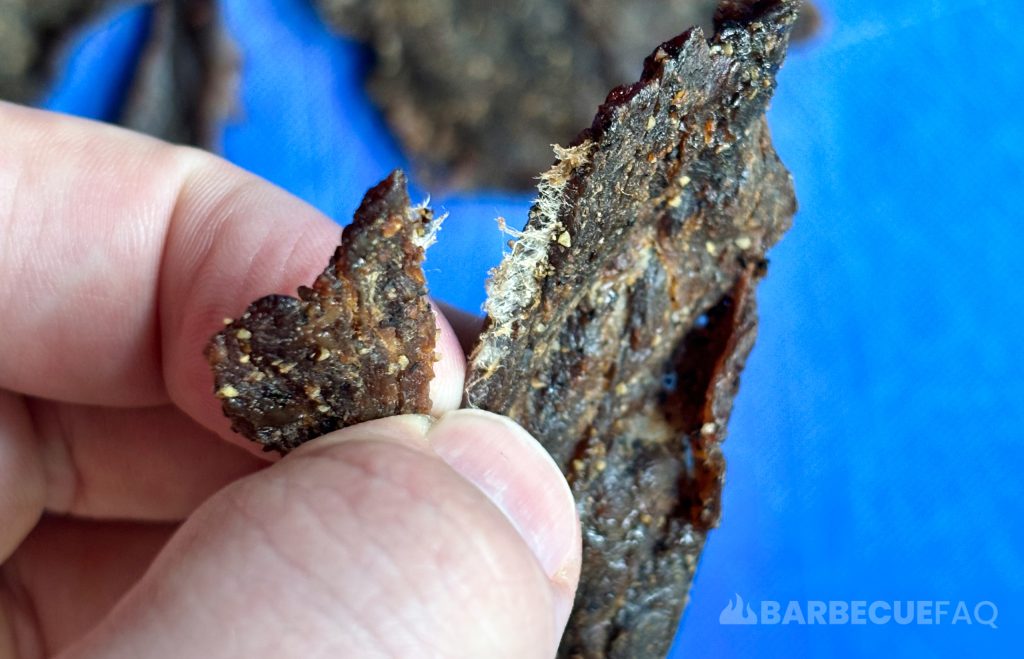
Cool Down in a Bag with the Lid Open
Leaving the top open lets the jerky aerate and prevents moisture from building up in the bag.
This process also lets the moisture re-distribute in the slices.
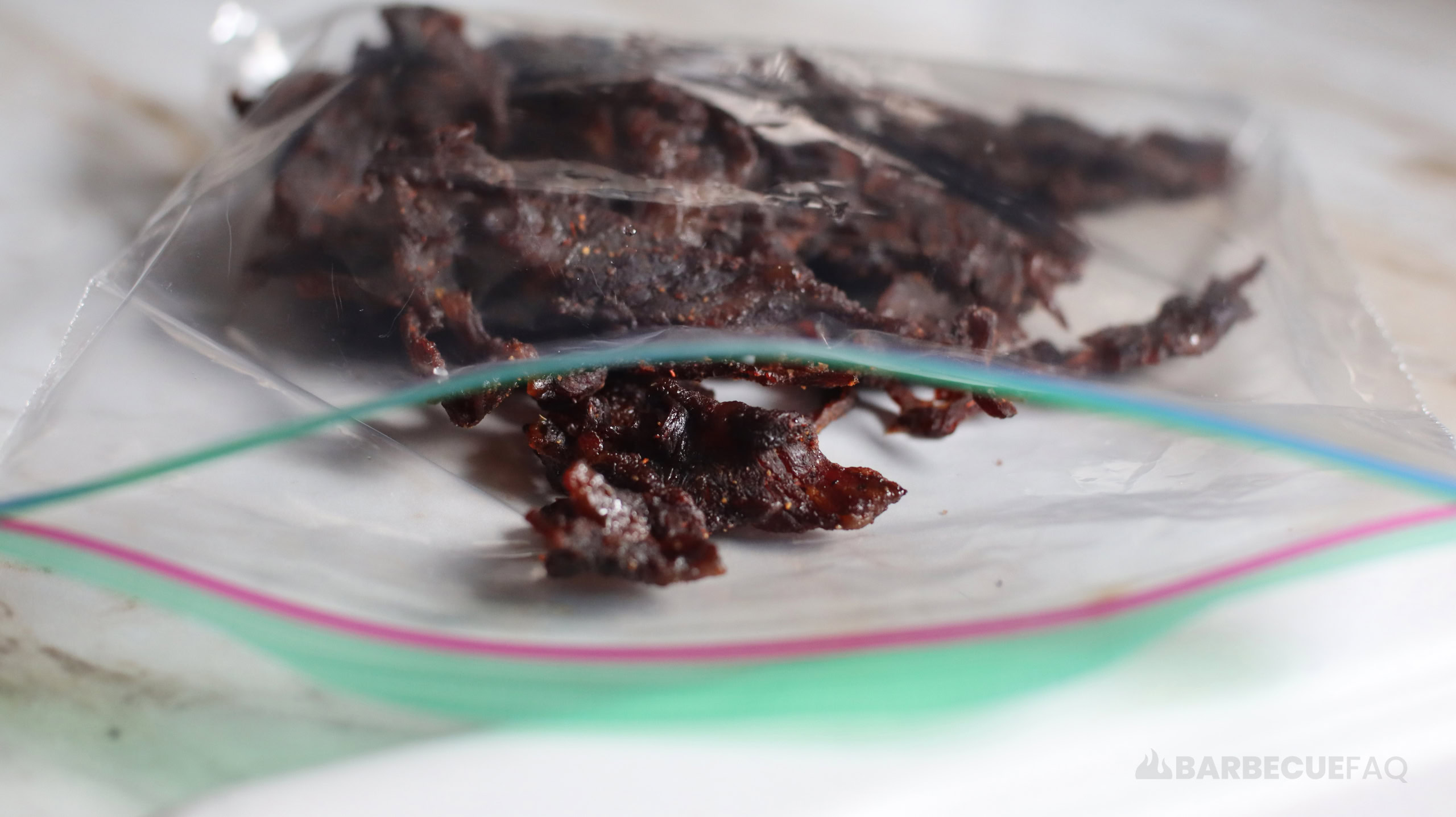
Once the jerky cools, I force out residual air, close the bag, and put it in a cool, dry, dark place.
Eat within 2 weeks.
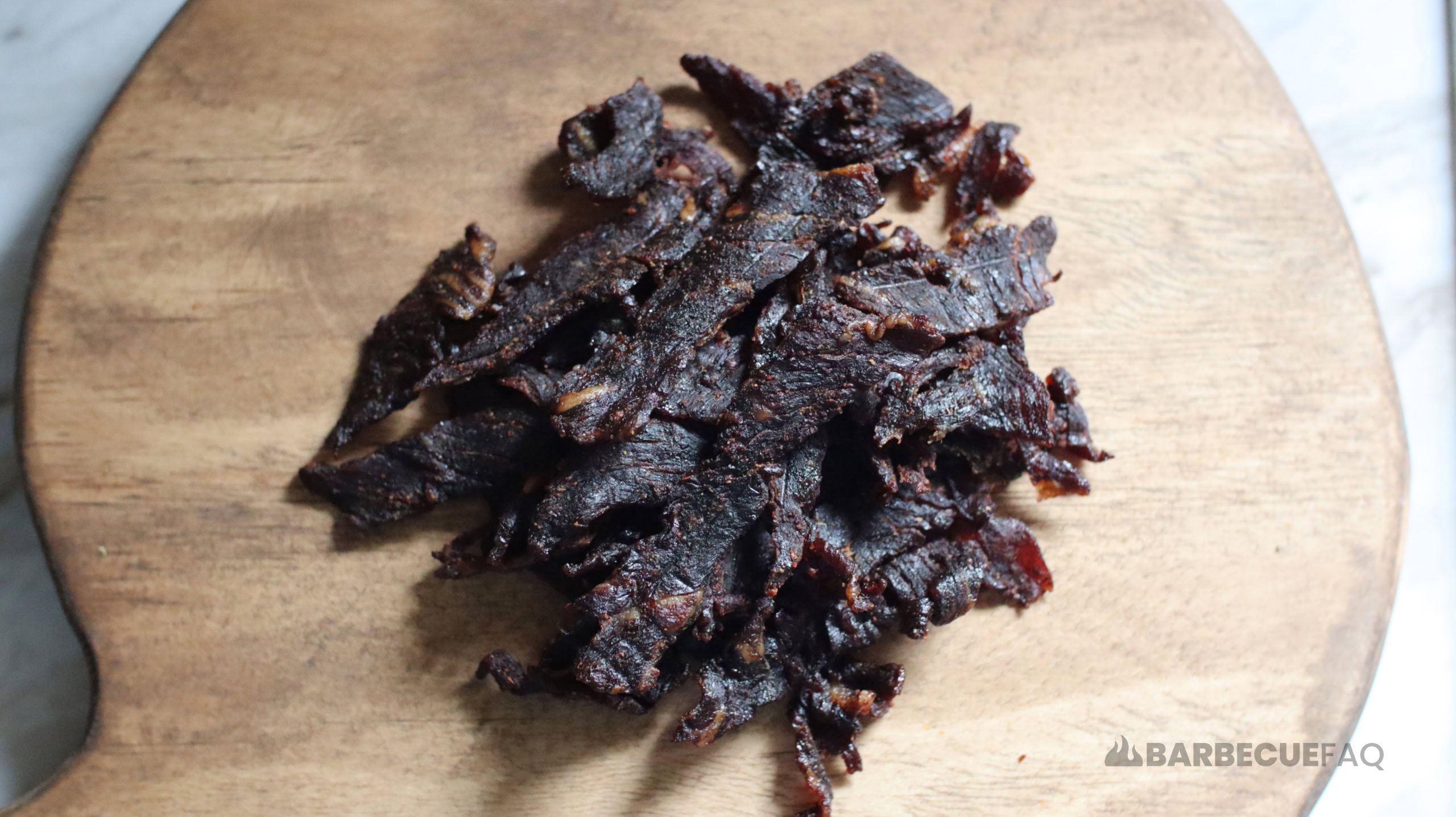
Sweet-Chili Beef Jerky
Ingredients
- Any cut of lean beef
Marinade
- 1 Tbsp Diamond Crystal Kosher Salt
- 1/2 Cup Water
- 1/3 Cup Molasses
- 1/2 Tbsp Distilled White Vinegar
- 1 Tbsp Dark Brown Sugar
- 1/2 Tbsp Black Pepper
- 1/2 Tbsp Chili Powder
- 1/2 Tbsp Garlic Powder
- 1/2 Tbsp Onion Powder
- 1/2 Tbsp Smoked Paprika
- 1/2 Tbsp Cloves
Instructions
Slicing the Jerky Meat
- If your meat is thawed, put in freezer for 30 minutes. If your meat is frozen, defrost in refrigerator until the meat is somewhat frozen/malleable.Any cut of lean beef
- Trim the meat, removing any exterior fat/silver skin.
- Identify the grain direction of the meat and slice either with or against it. If you prefer soft jerky, slice against the grain. If you like jerky with a bit of "tug" slice with the grain.
- Slice the jerky between 1/8 – 1/4" thick.
Create Jerky Marinade and Marinate Jerky
- Combine the marinade ingredients in the specified quantities in a bowl and ensure the salt, molasses, and dark brown sugar are well combined.1/3 Cup Molasses, 1/2 Tbsp Distilled White Vinegar, 1 Tbsp Dark Brown Sugar, 1/2 Tbsp Black Pepper, 1/2 Tbsp Chili Powder, 1/2 Tbsp Garlic Powder, 1/2 Tbsp Onion Powder, 1/2 Tbsp Smoked Paprika, 1/2 Tbsp Cloves
- Put your sliced jerky meat in a ziplock bag. Then put your marinade into the bag with the jerky.
- Roll the bag on top of itself to force out air, then close the bag. Leave the bag in your refrigerator overnight. My jerky marinated for 19 hours and 27 minutes.
Heat Treating Jerky for Lethality
- Pre-heat your oven to 350F.
- Take out baking pans and line it with aluminum foil. Then put oven safe cooling racks on top of the pan so that the jerky is elevated. Elevating the jerky also helps prevent case hardening.
- Arrange the jerky on the cooling racks so that they don't overlap and so that they interact minimally.
- Place temperature probe in the thick piece you sliced. You want the probe to reach the thermal center of the meat.
- Once the oven is pre-heated, put the baking pan on the middle rack and wait for the thick piece to reach 158F internal. When the thick piece is 158, the thin pieces are also 158. This process takes roughly 10 minutes.
- While waiting for the jerky to reach 158F, get your dehydrator to 130-160F – I used 131F on my dehydrator.
Dehydrating the Jerky
- Once heat treated, take the jerky out and start placing them on the dehydrator trays. You want the jerky so that it's not overlapping and so that they aren't touching.
- Simply wait for the jerky to be done. As you might expect, thin jerky finishes faster than thick jerky. If you sliced thin, check after 3 hours of dehydrating and then every 30 minutes to an hour after that.
Checking for Doneness
- When checking for doneness, bend the jerky to expose the muscle fibers. If you see hues of red/pink, the meat is visibly moist, or it's rubbery, it needs to dehydrate longer.
- If the bend is dry and has white spider-webbing, it's considered done.
- As the jerky finishes, put into a sandwich baggy with the top open. This way you prevent condensation from happening inside the bag and you allow heat/moisture to escape. Once it's cool, close the bag and store in a cool/dry/dark place.
- For longer storage, use a freezer bag/vacuum sealer with food-grade desiccant bags.





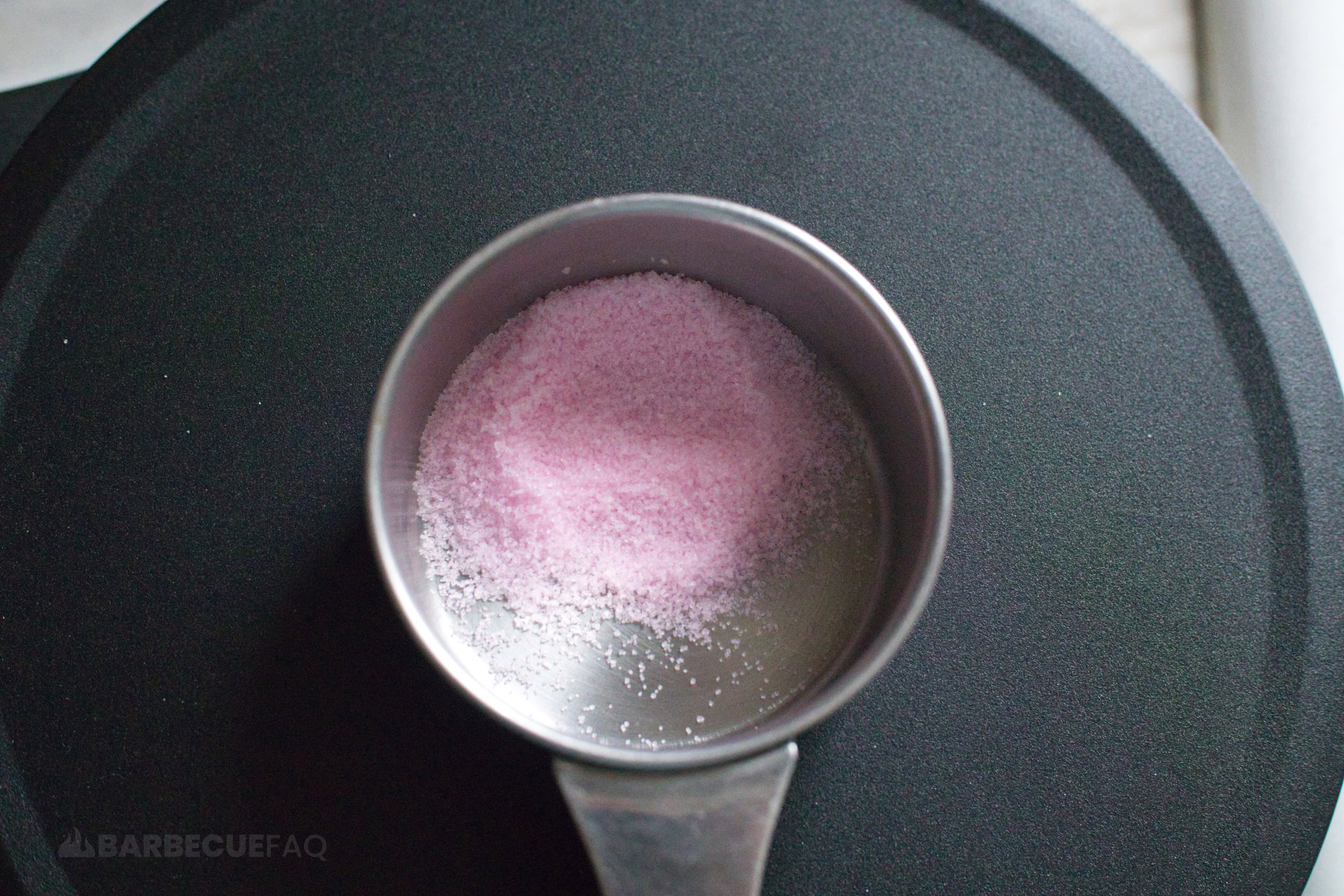
6 comments
Miriam
The first set of ingredients include water and salt and the second don’t
Which is correct?
Dylan Clay
The 2nd set Miriam, my apologies. I’ll get that updated.
Edit: So they both have the same ingredients 🙂 – the order is just different.
Tammy
Hi can I make this just in the oven without a dehydrator? I don’t have a dehydrator, and I love sweet chili. Thank you.
Dylan Clay
Hi Tammy!
So it really depends on your oven and how low it can go.
Most ovens can only go as low as 200F BUT you can crack the door slightly with a wooden spoon to help keep the temp down. My oven has a “keep warm” setting that is ~170F. For things like dehydrating I always tell people to ensure their oven is accurate too because in most cases they’re off by like 10-20F.
If your oven is newer and it has a “convection bake” setting, use it. This setting uses the fan more and mimics what a dehydrator does and helps to dry out the surface.
I’d also suggest using oven safe racks over a baking pan, this will help air circulate all around it.
So: 200F oven, convection bake if you can > door cracked with a spoon > use oven safe racks over a baking pan and then allow to go for 3 hours before checking for doneness.
Hope that helps!
Jonathan Parker
Incredibly useful resource – I’ve saved this to use for all my Jerky endeavors. The sweet/chili marinade is also delicious and all those flavors pair really well.
Dylan Clay
Happy to help Jonathan! Glad you liked the marinade as well (it’s one of my secret recipes I’ve saved for nearly a decade).